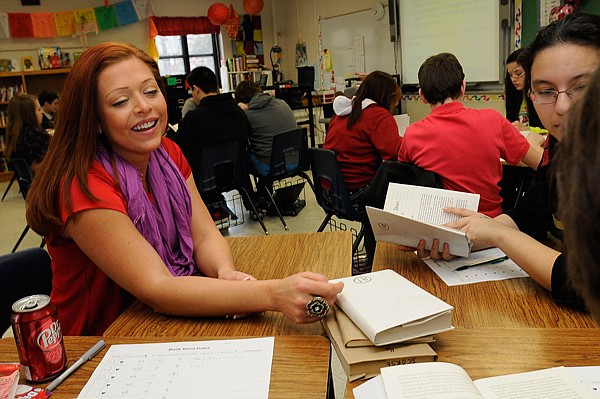Teens Look At Gender Bias
BOOKS MAKE FOR VALENTINE’S DATE AT SCHOOL
Teacher Yvonne Scorse works with students on Friday Feb. 14 2014 during the hidden-cover book exercise.
Saturday, February 15, 2014
Abook was the Valentine’s Day date for some students at Elmwood Middle School Friday.
Students picked up gift-wrapped titles in the library, and in Yvonne Scorse’s class they swapped books wrapped in white paper in an eff ort to skip book cover bias and read something new.
Books are judged by their covers, and they shouldn’t be, said Scorse, an English teacher.
“I want us to quit thinking in terms of boy books and girl books,” she told the eighth-graders.
She wrapped the covers and title pages of 50 books from her classroom library and had students fl ip through them on a book “speed date.” Students spent a few minutes skimming a title, then rated it on a scale of “love” or “not for me” as part of their date. Some checked the books out at the end of class.
Marketing can skew book covers to men or women. See examples of book covers redesigned to skew opposite of their initial marketing campaign by searching hashtag #coverflip on Twitter, Tumblr or any search engine.
Students tend to pick books that read a certain gender, Scorse said. Sports and science fiction read as “guy” books and stories that center on relationships ended up on a shelf in her classroom titled “girl books.” That was a mistake, Scorse said. Her students missed out on great reads because of a gender label.
Readers can favor a certain genre, but the book Valentines were aimed at breaking stereotypes, Scorse said.
One of Scorse’s students told her he’d liked the book he found during the speed date read because it seemed to be about travel and adventure. When Scorse removed the wrap, the cover was a closeup of a Geisha girl with brightly painted lips. It wasn’t what he was expecting, she said.
Enzo Vargas said his friends told him he was reading a “girl book” when he picked up “City of Ashes” by Cassandra Clare. A girl is on the cover of the first book, but later in the series, a cover features a shirtless guy, he said. Enzo said he avoided the people who criticized him while he fi nished the series. The books may be about a girl with supernatural powers, but they kept him on the edge of his seat with the plot twists, he said.
“The cover doesn’t really affect me as much as the contents inside the book,” he said.
Cole Regier put down his copy of “Maximum Ride” by James Patterson for a few weeks because he was teased for reading it.
The problem wasn’t the content of the book, Cole said, but a change in the cover. An early edition featured a dark winged figure on the front. The edition his friends took issue with had a girl on the front. A girl on the cover might make people assume it’s a romance, Cole said.
Movies, too, can infl uence the perception people have of a book’s plot, Cole said, pointing to movie trailers for the “Hunger Games” that push romantic themes to the front of a story that’s about survival.
“An exceptional book is an exceptional book,” he said.
Melissa Artman, school librarian, checked out “blind date” books on Friday. Students could browse the books by the keywords she’d printed as a label on the wrapped titles. Once they unwrapped the book, she asked them to give it a three chapter chance, relating the experiencing to a date. All the wrapped books were gone by 11 a.m.
Being a librarian is a bit like running a book-to-person matchmaking service, Artman said.
“All day long I’ll be thinking, ‘This book will go with that person’,” she said.
The wrapped covers give students a chance to expand their horizons, she said.
“What I think makes a good book is if you can relate to it,” said Julie Corona, a student.
She’ll pick up a book, look at the cover, title and, maybe, read the back or a couple pages to make her decision. She wants to feel a connection to the characters and the subject matter, she said.
Gender expectations are not limited to books, said Avery Ribel, an eighthgrader.
“Girls can wear things that used to be considered guy clothes and guys can’t do that at all,” she said.
Scorse said she will keep wrapped books on her classroom shelves to help combat cover bias.
“It’s so easy to go, ‘Oh, that’s not for me,’ based on the cover,” Scorse said.
“What I think makes a good book is if you can relate to it.”
JULIE CORONA
Student
